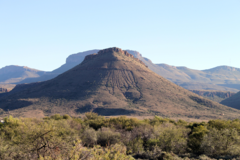Teekloof Formation
| Teekloof Formation | |
|---|---|
Ma | |
 | |
| Type | Geological formation |
| Unit of | Adelaide Subgroup, Beaufort Group |
| Overlies | Abrahamskraal Formation |
| Thickness | up to 300 m (980 ft) |
| Lithology | |
| Primary | Mudstone, siltstone |
| Other | Sandstone |
| Location | |
| Coordinates | 32°56′56″S 25°48′58″E / 32.949°S 25.816°E |
| Region | Western, Northern & Eastern Cape |
| Country | |
| Type section | |
| Named for | Teekloof Pass |
 | |
The Teekloof Formation is a
Loxton, Victoria West and Richmond.[4]
Geology
The Teekloof Formation overlies the Abrahamskraal Formation and is not capped by any other preserved sedimentation. Only East of 24ºE does the preservation of Beaufort Group rocks continue. There is no rock preservation in the western-southwestern portions of the Karoo Basin.[5][6][7] It is unclear whether rock preservation there ceased in the Late Permian due to localized basinal tectonics, or if that rock material was preserved but later weathered away.[8] The Teekloof Formation has five subdivisions or members which are listed below (from oldest to youngest):
- Poortjie Member - Correlates with the Pristerognathus Assemblage Zone
- Hoedemaker Member - Correlates with the Tropidostoma Assemblage Zone
- Oukloof Member - Correlates with the Cistecephalus Assemblage Zone
- Steenkampsvlakte Member - Correlates with the Daptocephalus Assemblage Zone
- Javanerskop Member - Correlates with the Daptocephalus Assemblage Zone
Lithologies
The
carbonate nodules and also fossil gypsum rosettes occur in the mudstone deposits. Interbedded with the mudstone deposits are minor channel sandstones ranging from pale olive to greenish-grey in colour. The sandstones are fine to medium grained and preserve fining-upward sequences (e.g. from bottom to top: Massive, horizontally laminated, trough cross-bedded, and ripple cross-laminated sedimentary structures). In the uppermost sections of the Teekloof Formation, the Javanerskop Member contains ribbon-shaped, single storied sandstones. These sandstones in the uppermost sections contain numerous erosional surfaces lined with siltstone or mudstone pellet conglomerates.[9][10]
carbonate nodules. The sandstone occurrences preserve evidence of deposition on point bars in a meandering river system. Seasonal waning flood level events are indicated by the fining upward sequences.[11]
Paleontology
The Teekloof Formation is rich in
therapsids Diictodon and Tapinocaninus have been found by the town Fraserburg.[12][13][14][15][16][17][18]
References
- ^ Keyser, A. W., and Smith, R. M. H. (1978). Vertebrate biozonation of the Beaufort Group with special reference to the western Karoo Basin. Geological Survey, Department of Mineral And Energy Affairs, Republic of South Africa.
- ^ Keyser, A. W. (1979). A review of the biostratigraphy of the Beaufort Group in the Karoo Basin of South Africa. Geocongress, Geological Society of South Africa, 2, 13-31.
- ^ Kitching, J. W. (1970). A short review of the Beaufort zoning in South Africa. In Second Gondwana Symposium Proceedings and Papers (Vol. 1, pp. 309-312).
- ^ Rubidge, B. S. (ed.) 1995b. Biostratigraphy of the Beaufort Group (Karoo Supergroup). South African Committee of Stratigraphy. Biostratigraphic Series 1. Pretoria, Council for Geoscience.
- ISSN 0078-8554.
- ^ Day, Michael Oliver (2014-03-04). Middle Permian continental biodiversity changes as reflected in the Beaufort Group of South Africa: a bio-and lithostratigraphic review of the Eodicynodon, Tapinocephalus and Pristerognathus assemblage zones (PhD thesis).
- .
- S2CID 56420970.
- ISSN 1527-1404.
- ISSN 1012-0750.
- ^ Smith, Roger M. H. (1989). "Fluvial facies, vertebrate taphonomy and palaeosols of the Teekloof formation (Permian) near Beaufort West, Cape Province, South Africa".
{{cite journal}}: Cite journal requires|journal=(help) - .
- S2CID 85752458.
- S2CID 86173425.
- ISSN 0078-8554.
- ISSN 0078-8554.
- PMID 28168104.
- S2CID 132638244.
